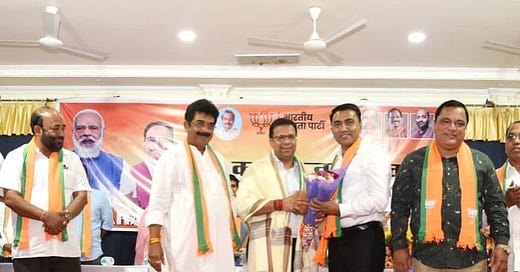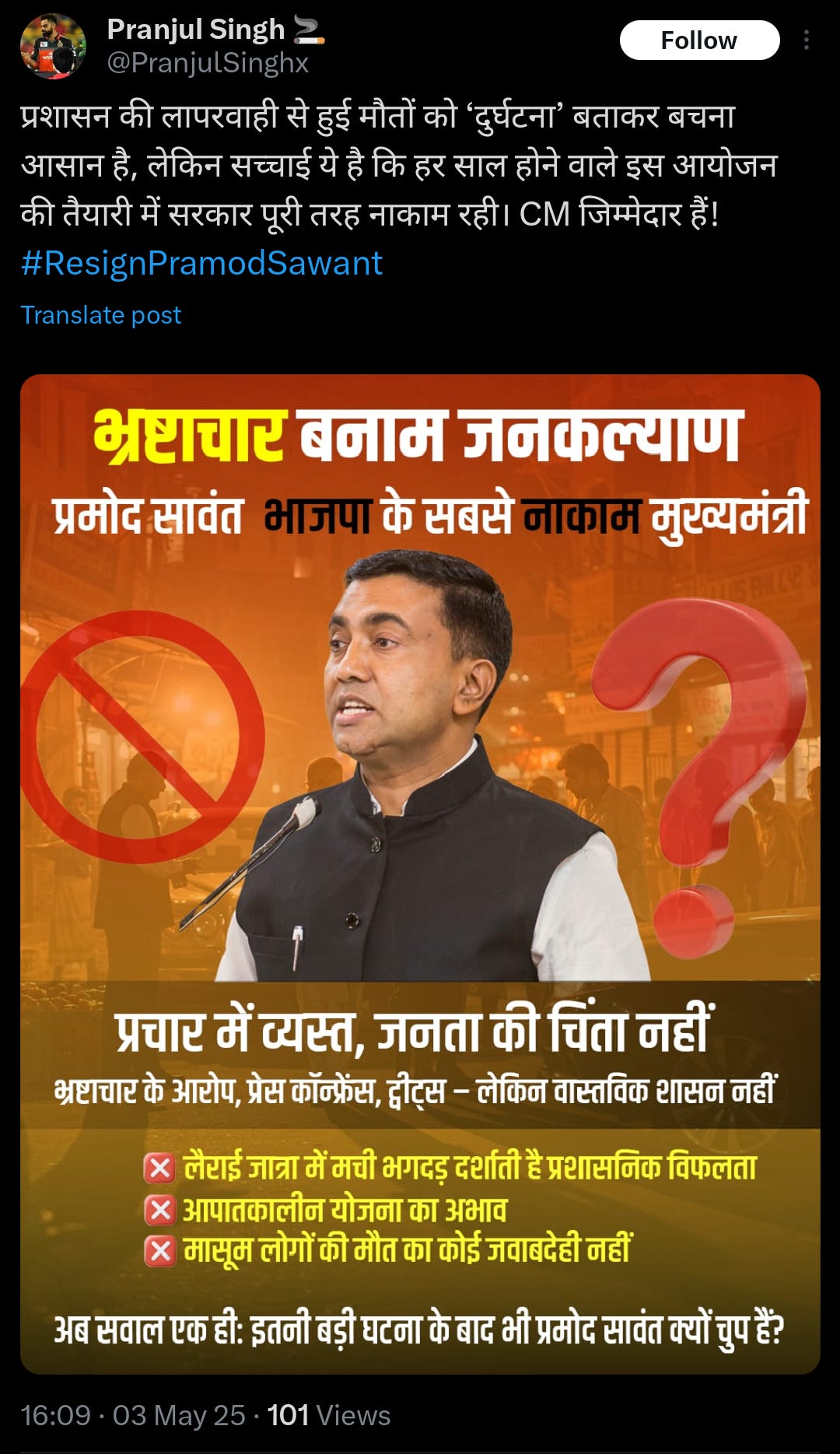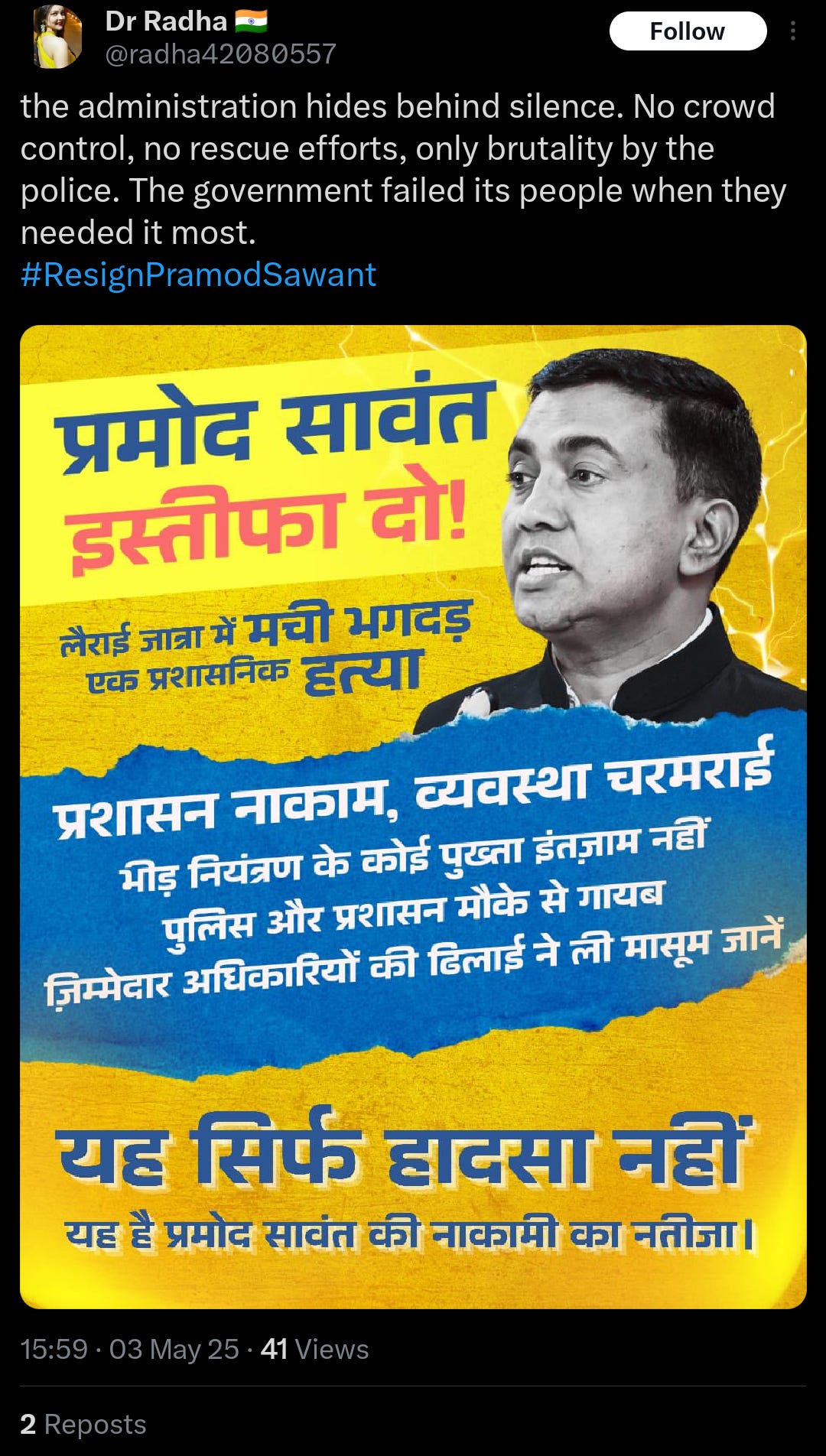"There are decades where nothing happens; and there are weeks when decades happen" is a quote that is often attributed to Vladimir Lenin. The week gone by was one such week. Since we last met, India and Pakistan started, and then ended what threatened to be an increasingly fraught exchange of fire (to put it mildly) with drones, missiles and shelling that was supposed to end on Saturday evening, but not before scores of civilians in Jammu & Kashmir were killed by enemy fire, civilian and military infrastructure was targeted and air defences were activated.
The reason I’m mentioning this in an otherwise Goa-focused newsletter is because of how the (TV) media portrayed (or exposed) itself on a global stage. On one end of the spectrum were hyperventilating news anchors who were running stories of the Pak army chief being arrested, Karachi and Islamabad being attacked and what not and at the other end of the spectrum was the government that was blocking and censoring accounts or ordering social media platforms to take down content of reputable commentators and analysts. Lost in the middle was the sensible public (people who seem to be in a minority nowadays) looking to find out what’s actually happening.
I understand my readers are already convinced about the need for a free and independent media (else you wouldn’t be here reading this), but if you aren’t, perhaps the events of the past week have changed your mind? And if you believe that what I write deserves to be widely read, don’t hesitate to share and recommend the newsletter to everyone you can think of.
Here in Goa there were civil defence drills conducted allegedly to test the responsiveness of civil defence forces to a wide range of possible emergencies including the simulation of a Mandovi bridge collapse scenario leading to a rescue and evacuation drill (all while people continued gambling on casinos). Drills conducted, the state administration declared them a success. But as an eyewitness to the drill told me: “It was so bad… In case an attack actually happens, God help us!”
Welcome to yet another edition of Gerard’s Gazette, a weekly newsletter in which I attempt to break down the events of the week gone by and offer a bit of context, as well as a dose of news you may have missed and news behind the news.
If this is your first time here, thank you for signing up, and I hope you stick around!
Who’s the real chief, chief?
The big story this week was the multiple orders issued for the appointment of a Chief Town Planner in the Town and Country Planning Department.
As you will be aware, outgoing Chief Town Planner Rajesh Naik, who was on an extension, was suspended on the day he was due to retire -- April 30.
But appointing his successor has proven to be a messy affair for the government, but luckily for us has shone light on exactly what is happening behind the scenes in this government and how exactly it is being run.
Here’s what happened: On Monday, the personnel department, headed by Chief Minister Pramod Sawant, issued an order appointing senior town planner R. K. Pandita as the next chief town planner to succeed Rajesh Naik. However, the Town and Country Department thought it wise to appoint its own head of department – a job usually done by the Personnel Department.
In an order issued the very next day, the deputy director (admin) of the TCP Department, Nadia Shekoli “conveys the decision of the government to give additional charge of the Chief Town Planner (Planning) to Vertika Dagur, in addition to her own duties, with immediate effect, until further orders.”
Aside from being poorly worded, the so-called order was silent on what it really meant by ‘decision of the government’. Clearly, the decision of the ‘government’ it would appear was already conveyed via the aforementioned order issued by the Department of Personnel. Besides, how can a deputy director be issuing an ‘order’ on who the ‘director’ in this case, the Chief Town Planner, who is the head of the Town and Country Planning Department, will be?
Can a subordinate appoint her boss?
Yet that’s what the situation was for a few days -- a standoff between the Chief Minister and the Town and Country Planning Minister with the latter even posing with Vertiga Dagur to congratulate her for being appointed as Chief Town Planner.
It wasn’t until Thursday evening (the original orders were issued on Monday and Tuesday) when the department personnel issued a fresh order stating that R K Pandita shall hold charge of Chief Town Planner (Land Use), who was declared as Head of the Department, while Vertiga Dagur shall hold charge as Chief Town Planner (Admin) and Chief Town Planner (Planning).
What does this all mean? For the longest time (ever since the TCP Act became a law in 1974), Goa only had one Chief Town Planner – a sole head of department under whom the department was to function. But then along came Vijai Sardesai, who became Town and Country Planning Minister in 2017 (shortly after his ‘great betrayal’), and who decided that he wasn’t happy with the then Chief Town Planner S T Puttaraju and, rather than have him transferred or kicked upstairs (neither of which was possible), decided that the way forward was to be an amendment to the Town and Country Planning Act to have not one but three Chief Town Planners – for planning (duh!), land use and administration.
According to the amendment to the Act passed in the Legislative Assembly back then, which was justified on grounds that “the work and the responsibility of the department have increased manifold, and the difficulty is finding it difficult to function with limited resources and manpower”, the Chief Town Planner (Planning) will be the Member Secretary of the Town and Country Planning Board, and also be in charge of draughting Regional Plans for the state of Goa, its notification and enforcement.
The Chief Town Planner (Land Use) shall have the role of preparing the maps and register in areas falling in the Outline Development Plans (ODPs). But the Chief Town Planner (Planning) will have the task of preparing the Outline Development Plan. All development permissions will also be issued by the Chief Town Planner (Planning).
The Chief Town Planner (Administration) will deal with appeals against decisions passed by the Planning and Development Authorities and deal with questions over violations in the Planning and Development Areas.
As is evident from the roles elucidated above, the Chief Town Planner (planning) is the real deal; the other two only have a limited role, with the title of ‘Chief’ being just that – a title with little real power.
Back during Sardesai’s time this amendment was used to promote the now-infamous Rajesh Naik to the post of Chief Town Planner (Planning) and edge out the then head of department Puttaraju, who, while retaining the title of ‘chief’, lost all his powers due to the redefined roles.
With this in mind, let’s examine the latest orders. As should be evident to you now, R K Pandita, who was initially appointed by the Department of Personnel as the Chief Town Planner, though appointed as head of the department, has been given charge of land use, while Vertiga Dagur, whom Rane congratulated and posed with, has been given charge of planning and administration.
I need not explain further who really gets to ‘head’ the department. Moreover, you could always make the case that, irrespective of which bureaucrat heads the department, there’s only one person who calls the shots, and such decisions of little overall consequence matter little.
This isn't to suggest that Pandita is a saint or that Dagur isn’t one. In fact, there are complaints against Pandita too and some of them will surely be raked up now.
But what it does undoubtedly indicate is that just as the TCP Department has multiple ‘chiefs’, so does the state government. In theory there may be only one ‘chief’ minister, but several other non-chief ministers seem to seem to have more powers than the one who’s actually designated as the ‘head’ of the cabinet.
What’s even more surprising (actually no, it isn’t, at least not to me) is that this isn’t even the first time this is happening.
You see, back in 2021, the Goa government appointed Dr J P Tiwari, the then head of the Nephrology Department, as Dean of the Goa Medical College. The order was issued based on the recommendation of the Goa Public Service Commission, a constitutional body tasked with recommending appointments to top level government posts.
Within hours, the government put the order on hold and allowed Dr S M Bandekar (who was then holding the post on an ad-hoc basis) to continue to be dean. Dr Bandekar was appointed ad-hoc dean after the previous Dean Dr Pradeep Naik, was similarly mistreated by the government (or a certain someone in the government). Dr Naik, was removed from the post of Dean in February 2019 (soon after Parrikar’s death, no less) and asked to report to the Public Health Department, where he remained without any official posting until his retirement.
The only thing surprising (even to me) about the whole thing is how does he keep getting away with it?
There are many such stories, especially from the Health Department but also from other departments, and they are certainly not restricted to just one or two ministers. If you know of any such stories, do not hesitate to reach out and I will try and do what I can to say what is otherwise spoken in hushed tones in the corridors of power, out loud, because that’s exactly what this newsletter is for.
Who’s actually politicising the stampede
It’s been a week since the stampede at the annual Shirgao zatra claimed six lives and left scores of others injured, some of them seriously. But the incident has quickly been relegated to the inside pages of the newspapers -- not so much out of neglect, but simply because worse things have started happening since then.
But one way or another, the general pessimistic consensus was that the incident would be forgotten (except by those whose lives have changed forever), and there would be no real accountability or soul-searching by those who either triggered it or those who allowed it to happen. The four member fact-finding committee headed by Revenue Secretary Sandip Jacques has submitted its report, which is currently being examined by the government. But like most reports, I expect it will be forgotten.
The immediate refrain, especially by those from the ruling side, was to call on people (read: opposition parties) to not ‘politicise the issue’. Which, frankly, is only another way of saying, don’t blame us for what happened.
However, instead of telling the opposition not to politicise the issue, the operatives of the ruling party really should have focused on keeping their own house in order.
Allow me to explain. And before I proceed, I must acknowledge that the following was noticed by someone within the government who has done the hard work of putting it together. What you also must know is that when something like this is leaked from within government, the leakers probably have some personal interest in doing so.
As you can see below, there are a couple of screenshots from an X (formerly Twitter) handle going by the name @PranjulSinghx. The said Pranjul Singh, it appears, is an account for hire but mostly posts pro-BJP or pro-ruling government tweets. In fact, in April last year, he was posting tweets with the hashtag #Sattari4Modi2024 (as can be seen in the screenshot below).
Why is it then, in the aftermath of the Shirgao temple stampede, he was tweeting (and retweeting) several tweets with the hashtag #ResignPramodSawant, blaming the incumbent chief minister for the loss of lives?
Generally speaking, yes, the chief minister deserves his share of the blame, especially since the buck stops with him, but why is it coming from a handle that is otherwise in awe of the work the Goa government is doing in Sattari?
Then there’s a profile by the name Dr Radha (@radha42080557) who last year was talking about a #ModiWaveinSattari is tweeting and retweeting for the resignation of the Chief Minister. I’ve put the handles so you can verify the tweets for yourself, just as I have. Screenshots below.
There are at least half a dozen such accounts that I was able to find. Assuming these are mercenary accounts that somehow have an affinity only towards right-wing content, the question that arises is who's paying them to go against one of their ‘own’?
It isn’t really a question because you already know the answer. So the next time someone from the ruling side asks you or anyone you know not to politicise the issue, keep in mind that they have already done what they are asking you not to do.
That’s all I have for you this week. Make sure you comment or write in, should you have something, anything to say.
I would also invite you to contribute via sending in your views, especially on a subject you know something about, and I will be happy to include it as part of the newsletter.
You are also welcome to write in with leads and tip-offs or anything that you think might be interesting enough to include here.
As always, please share and help spread the word.
Until next week, then. Tchau!









Fantastic. Keep it up Gerard. You nailed the hide of the Sattari mercenary.